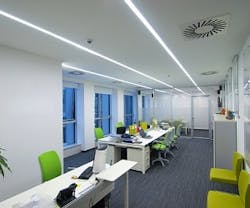According to data reported by IBM’s Smarter Buildings initiative, buildings will become the largest consumer of global energy by 2025 if current usage trends continue―more than the transportation and industrial sectors combined. Not only are buildings consuming more and more electricity, emitting greater levels of carbon dioxide, and wasting more water, fewer and fewer occupants are actually using energy efficiently in their daily operations. While the trend’s negative impact on the environment is clear, the impact on commercial building owners is a far more complex discussion.
Primarily, the economic recovery continues to be a slow improvement at best and one of the key factors contributing to energy waste. While some regions of the U.S. are rebuilding faster than others, across the nation, companies that were hard-hit by the recession have been left with too few employees to occupy vacant floor space. What’s more, a recent study from Regus and Unwired Research found that more than 55% of desks in an average office are empty at any one point in time. The reality is, underutilized and unoccupied space is a waste of energy, as most companies are unable to control how they light, heat and cool their offices. Instead the energy levels of these offices remain at full capacity, even if they are operating at less than half.
Secondly, the era of the traditional office is quickly coming to an end. No longer is business conducted from 9-5 in a single office building. Today’s workforce is highly mobile, equipped with laptops, tablets and smartphones – all the tools needed to maintain a virtual connection to the office from a remote location. This mobile workforce trend is expected to continue. By 2013, experts estimate there will be 1.2 billion mobile employees worldwide. Still, most companies today maintain a dedicated headquarters, and that too is often a center for energy waste for both the organization itself and the building owner who is unable to maximize revenue from available floor space.
Lastly, because more and more companies are “going green,” the importance of offering environmentally friendly amenities has never been greater for building owners. The reason? Properties that present themselves as “green” are perceived as higher-end and more appealing to prospective, like-minded tenants. Unfortunately, unless a building owner has made structural changes or significant upgrades to their properties, the cost of doing so in compliance with today’s green standards is extremely expensive. For many, offering comprehensive green amenities is simply not a long-term viable option.
For commercial building owners who are facing losses from wasteful tenants, or who want to offer greener workspaces to potential occupants without the massive capital expense, there are viable options. One effective way is by partnering with flexible workspace providers, which enable building owners to more quickly gain control over a building’s energy consumption as well as achieve higher levels of occupancy overall. In fact, one of the energy benefits of shared workspaces is the ability to drive down the unoccupied rate of the space. In short, more occupancy often results in better use of energy.
By partnering with a flexible workspace provider, commercial building owners are given the resources needed to lay the groundwork for greener, better functioning properties. For the energy-savvy building or new constructions, many flexible workspace providers will conform to green practices, such as LEED-based requirements. Additionally, for building owners who do not have the budget to embark on costly construction projects or renovations, such as the Empire State Building’s retrofit project, flexible workspaces provide the basic needs to help both create and attract energy-minded tenants at a fraction of the cost. From installing energy-saving light sensors to sophisticated meters that more accurately read electricity and gas usage, building owners can reduce operating and maintenance costs, maximize returns on investments and protect the environment.
Additionally, many flexible workspace providers offer premium on-site amenities that appeal to companies who are committed to going green. For example, organizations that are committed to reducing their carbon footprints will commonly put travel bans in place, despite a need to operate nationally or even globally. For those companies, telepresence and video conferencing capabilities can be a major incentive when selecting a workspace. Both technologies are often available from flexible workspace providers and can be used on-demand, by all tenants occupying an office building. Having immediate access to these two extremely expensive, yet valuable, amenities will help building owners to increase the real estate value of their properties.
While the challenges associated with energy efficiency cannot be solved overnight, flexible workplace solutions offer commercial property owners a viable way to not only better-manage the energy consumption of tenants, but also entice future tenants who remain environmentally cautious. As a result, building owners are able to decrease their properties’ energy use and costs, carbon dioxide omissions, maintenance costs, water usage – driving longer terms occupancy and high tenant satisfaction overall.
Michael Berretta has more than 23 years of real estate sales and corporate development experience. He currently serves as Vice President of Development, Americas for Regus.